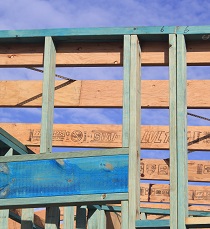Building Materials
Dangerous Building Materials
Choose building materials that enhance the health of people. Avoid building materials that damage health.
 Preferred building materials will have the following characteristics:
Preferred building materials will have the following characteristics:
- Regulate temperature as desired (e.g. trap sun, insulate, etc.).
- Chemically safe - usually being chemically inert (i.e. do not produce damaging fumes).
- Physically safe - no sharp or hard surfaces in places where a person might hurt themself.
- Do not attract/harbour pests.
- Have a desirable affect on humidity - some materials absorb moisture, some do not.
Chemical Effects On The Body
Some people are more affected by certain materials than others. Sensitivity may be no more than a mild allergy, or as much as life threatening allergic responses. In other instances, a body may be poisoned by toxins found in building materials. Exposure over a long period of time can result in a cumulative affect which eventually builds to levels with serious consequences.
Different chemicals affect the body in different ways. Many are specific (i.e. affecting a specific physiological process in the body). Others may have a broader, more general affect, perhaps causing cell growth to become abnormal, leading to cancers.
Considerations
There are many different types of materials used in buildings. These can include wood, masonry, ceramic tiles, plaster, concrete, metal, plastics, fibreglass, glass, glues/adhesives, paints/sealants, etc. Each of these has distinctive characteristics, some of which may be detrimental to health. Any material chosen for a building should be considered in terms of the following characteristics:
- Rate of deterioration.
- Some materials will deteriorate fast, others virtually never deteriorate.
- Deterioration can lead to the need to dispose of, and replace parts of a building. Waste is not only costly but can cause negative environmental impacts.
- Deterioration may also lead to greater use of chemical treatments such as pesticides or preservatives.
Thermal Qualities
- Some materials will absorb heat, others do not.
- By selection of materials for thermal qualities, you can reduce heating and cooling requirements for a building.
Chemical Properties
- Many building materials have some toxins in their make up.
- Sometimes these toxins are fully stable and pose no threat. Other materials contain unstable toxins which may be released into the building environment slowly (i.e. some paints). These can find their way into the human body and have a cumulative affect over time.
Acoustic Qualities
- Insulating against unwanted noise (e.g. neighbours or a road), may be desirable.
- Avoiding echoes may be important.
- Some materials are more suitable for absorbing, or insulating sound, than others.
- Some materials (e.g. impermeable hard surfaces such as tiles) will bounce sound around a room.
Dust Collection/Repellence
- Some materials will collect dust, which can be a problem for allergy sufferers
Light Reflection
- Some materials may absorb light energy, helping heat a building (providing a heat store).
- Some materials (e.g. glass) are translucent allowing light to penetrate indoors.
- Some materials reflect light. This can create glare and heat where it is unwanted, or it may help improve lighting where it is wanted.
Waste Created During Construction
- Particles created by cutting plaster, timber, metal etc. during construction is unlikely to find its way off your property. Even if floors are supposedly cleaned first, dust and other particles will often remain under carpets, inside walls and roofing, under cupboards or buried in the garden.
Timber
Some timbers are preferable to use for various reasons. Other are selected against due to the negative impact they may have upon human health.
Some Considerations
- Veneer timbers are usually made using glues that are preferably avoided.
- Treated pine contains chemicals which when burnt will release a poisonous gas.
- Smooth surfaces are easier to keep clean and dust free.
- Shrinkage in timber which has not properly been dried will open gaps that can attract pests, dust, etc.
- Timber with high natural durability may negate the need for using preservatives or pest control measures.
Formaldehyde Adhesives
Formaldehyde may be used in processing products such as plywood or chipboard. It is used as an adhesive. It can produce a vapour which is toxic. The health risk is determined by factors such as ventilation (both in walls and rooms), and environmental conditions. The emission of toxic gas can also vary according to the type of product, with some boards producing emissions for a very long time. Sealing the boards with varnish or melamine is one way of reducing (or stopping) the emissions.
ACS has been teaching about the environmental affects of building since the early 1990's.
[02/01/2026 09:48:28]